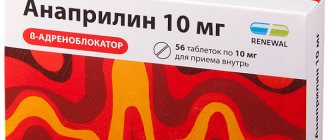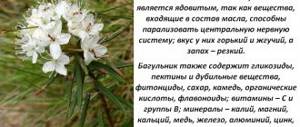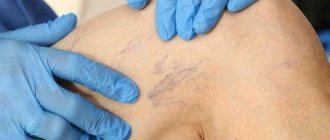Composition and release form of Wessel Due F
The drug is available in two dosage forms:
- In the form of capsules or tablets, Wessel Due F, containing the main active ingredient, sulodexide, in the amount of 250 LE per piece. Additional components: glycerol, titanium dioxide, red iron oxide, gelatin, sodium propyl paraoxybenzoate, sodium ethyl paraoxybenzoate. 25 pieces in a blister.
- A solution for intramuscular or intravenous administration containing in one ampoule the active substance, sulodexide, in an amount of 600 LE. Additional components of the solution are water for injection and sodium chloride. 10 ampoules per package.
Analogues of Wessel Due F
The pharmacy chain offers a wide range of Wessel Due F substitutes with similar indicators for use and treatment effect. Among the presented analogues of Wessel Due F, there are cheap medicines and at a higher price in the form of:
- synonyms;
- generics;
- combined means.
Russian analogues of Wessel Due F are not inferior to foreign drug substitutes in terms of treatment effectiveness and are actively used in therapeutic practice.
Table of analogues of Wessel Due F with price and country of manufacture
| Analogue | Cost in rubles | Manufacturer country |
| Wessel Due F | 2300-2750 | Italy |
| Clexane | 570-4500 | France |
| Detralex | 770-850 | France |
| Venoruton | 790-4950 | Russia |
| Fragmin | 1970-3500 | Germany |
| Heparin | 45-90 | Russia |
| Fenilin | 60-150 | Ukraine |
The price of analogues of Wessel Due F fluctuates over a wide range. This gives the doctor the opportunity to choose a medicine with a similar mechanism of action and an equivalent effect, but much cheaper than imported drugs.
A large selection of Wessel Due F analogues allows the doctor to select the appropriate drug that is most suitable for a patient with a certain pathological condition.
What else can replace Wessel Due F, what medications? The register of the basic product will include the following drugs in different release forms:
- Enixum;
- Anfiber;
- Cibor;
- Flenox;
- Sulodexide;
- Warfarin;
- Warfarex;
- Sinkumar.
These analogues of Wessel Due F can be purchased in a pharmacy only with a doctor's prescription, since treatment of serious vascular diseases is carried out exclusively by a medical specialist.
Clexane
Manufacturer: SANOFI WINTHROP INDUSTRIE (France)
Release form: injection solution
Active ingredient: enoxaparin
Clexane is a low molecular weight heparin that normalizes the blood coagulation system and prevents the formation of blood clots. The drug is used not only to treat already formed blood clots, but also to prevent their formation during any surgical interventions.
This analogue is administered subcutaneously once a day in an amount of 20 mg. The dosage of the drug can be adjusted depending on the type of disease and its activity.
Detralex
Manufacturer: Les Laboratories Servier (France)
Release form: tablets
Active ingredients: hesperidin, diosmin
This combined analogue in tablets has the property of reducing the distensibility of veins and venous stagnation, reducing the permeability of the capillary network and increasing their resistance. The effectiveness of Detralex is especially evident in the treatment of hemorrhoids and diseases of the veins of the lower extremities, relieving their pathological symptoms (pain, cramps, heaviness in the legs).
The Wessel Due F analogue is prescribed, 1 tablet 1–3 times a day according to indications. The dosage of the drug depends on the degree of damage to the veins and the clinical manifestations of the disease.
Venoruton
Manufacturer: GlaxoSmithKline Healthcare (Russia)
Release form: capsules
Active ingredient: rutoside
Venoruton is a drug that tones the vascular wall of capillaries and reduces their fragility. This analogue of Wessel Due F restores the structure of the vascular wall, which leads to normalization of its permeability to fluid and lipids. During the treatment of deep vein thrombosis and chronic venous insufficiency with medication, tissue swelling, convulsions, and pain are relieved.
These capsules of the Wessel Due F analogue are prescribed in a dosage of 300–600 mg 2–3 times a day. It is possible to adjust the daily dose of the drug depending on the activity of the process.
Fragmin
Manufacturer: Vetter Pharma-Fertigung (Germany)
Release form: injection solution
Active ingredient: dalteparin sodium
Fragmin is a direct anticoagulant, which is a low molecular weight heparin. The Fragmin analogue is active in the treatment of deep vein thrombosis, pulmonary embolism, myocardial infarction and unstable angina.
The drug is also used as a prophylactic agent to prevent the formation of blood clots in various conditions. The medication is prescribed subcutaneously 1–2 times a day, depending on the disease and its degree of activity.
Heparin
Manufacturer: BIOK (Russia)
Release form: injection solution
Active ingredient: sodium heparin
This analogue of Wessel Due F in injection ampoules is a direct-acting anticoagulant belonging to the group of medium molecular weight heparins. Heparin reduces the risk of primary and recurrent myocardial infarction due to coronary heart disease.
The drug has a positive effect in the treatment of deep vein thrombosis and pulmonary embolism. An analogue is prescribed individually in a dosage corresponding to the form of the disease.
Fenilin
Manufacturer: ZDOROVE (Ukraine)
Release form: tablets
Active ingredient: phenindione
Phenilin is a cheap tablet similar to Wessel Due F. It is an indirect-acting anticoagulant, used for the treatment and prevention of:
- thromboembolism;
- coronary artery thrombosis;
- deep vein thrombophlebitis;
- thrombosis after surgical interventions of various locations.
Treatment with Phenilin is prescribed according to a loading dose regimen on day 1 at a dosage of 120–180 mg in 3–4 doses, on day 2 – 90–150 mg, on day 3 – 30–60 mg under the control of prothrombin levels in the blood. Cancellation of the analogue is carried out with a gradual reduction in the daily dosage.
pharmachologic effect
The active component of the drug Wessel Due F is a natural product obtained from the mucous tissue of the small intestine of pigs. Externally, sulodexide is a mixture of glycosaminoglycans. According to the instructions, Wessel Due F has angioprotective, anticoagulant, profibrinolytic and antithrombotic effects on the body.
The anticoagulant effect of the drug lies in the affinity of heparin for cofactor II, which deactivates thrombin.
The antithrombotic effect of the drug is caused by the suppression of activated X factor, increased production of prostacyclin, as well as a decrease in the amount of fibrinogen in the blood plasma.
The angioprotective effect of Wessel Due F is to restore vascular endothelial cells, which helps to normalize the density of the negative electrical charge of the pores of the vascular basement membrane.
The profibrinolytic effect is due to an increase in the level of plasminogen in the blood and a decrease in the amount of its inhibitor.
According to reviews, Wessel Due F reduces the level of triglycerides, which helps normalize the rheological properties of the blood.
Pharmacological properties
The drug Wessel Due F has the following pharmacological properties:
- angioprotective;
- anticoagulant;
- antithrombotic;
- profibrinolytic.
Pharmacodynamics and pharmacokinetics
The mechanism of anti-trobotic action is manifested by blocking activated X factor, increasing the secretion and synthesis of PGI 2 and decreasing the level of fibrinogen in blood cells.
The profibinolytic property of this medication is explained by an increase in the level of plasminogen activator with a decrease in the number of its inhibitor in the blood serum.
The angioprotective effect of the drug is revealed when the structural and functional integrity of vascular tissues is restored, as well as when the density level of a negative type of electrical charge is restored.
Almost 90% of the main component of Wessel Due F capsules is absorbed inside the vascular tissue. It is in this part that the concentration of sulodexide is 20 times greater than in other tissues of the patient’s body.
The drug is absorbed by the small intestine. The medicine is eliminated within 4 hours after administration and is metabolized in the cells of the liver and kidneys.
Indications for use Wessel Due F
According to the instructions, Wessel Due F is prescribed in the following cases:
- deep vein thrombosis, phlebopathy;
- vascular dementia;
- cerebrovascular accident, including ischemic stroke;
- microangiopathies, including retinopathy, nephropathy, neuropathy;
- angiopathy, accompanied by a significant risk of thrombosis;
- macroangiopathies that occur with diabetes mellitus (cardiopathy, encephalopathy, diabetic foot syndrome);
- discirculatory encephalopathy resulting from diabetes mellitus, atherosclerosis, arterial hypertension;
- heparin-induced thrombotic thrombocytopenia;
- antiphospholipid syndrome, thrombotic conditions (as part of combination therapy).
Wessel Due F - instructions for use
According to the instructions for use of Wessel Due F, primary therapy with the drug is prescribed in the form of intramuscular or intravenous injections of 2.0 ml once a day for 2-3 weeks. After parenteral administration of the drug is completed, treatment continues by internal use of 1–2 capsules 2 times a day for 1–1.5 months.
A repeated course of therapy is recommended after 6 months. Depending on the indications, form and activity of the disease, the treatment regimen and dosage of the drug can be adjusted by the doctor.
Directions for use and dosage
Therapy with Merry Due F begins with parenteral intravenous or intramuscular administration of the drug . Over the course of 15-20 days, the medication is administered in a dose equal to one diluted ampoule. Before use, the contents of the ampoule are diluted in physiological solution (150-200 ml).
Next, the patient is transferred to capsules, which are taken twice a day for 30-40 days, 1 piece each. between meals. It is recommended to repeat the full course of treatment twice a year.
Release forms and composition
The drug is available in two main forms: soft gelatin capsules and a clear solution for injection.
Solution
One ampoule always contains 600 LE of the main active substance, which is sulodexide. Auxiliary components: purified water for injection and a small amount of sodium chloride.
One ampoule always contains 600 LE of the main active substance.
The solution is transparent and has a yellowish tint. Each ampoule contains 2 ml of pure solution. Cellular packages contain 5 ampoules. A cardboard box may contain one or two packages with cells.
Capsules
Gelatin-based capsules, soft. They contain 250 LE of the active compound. Additional substances include: silicon dioxide, small amounts of sodium lauryl sarcosinate, some triglycerides.
The capsules are red. Each tablet contains a specific grayish suspension. Sometimes the shade can be pink or cream.
All tablets are placed in special blisters of 25 capsules each. In this case, the original packaging must contain instructions for use.
Composition and effect of the drug
Wessel Due F is a medicinal product whose active component is sulodexide, a natural substance obtained by extraction from the intestinal mucosa of pigs. The medicine also contains the following elements:
- sodium lauryl sarcosinate;
- colloidal silicon dioxide;
- triglycerides.
The drug is produced in the form of small oval capsules of a reddish-brown color with a soft jelly structure. The medicine is also available in the form of an injection solution.
Its main purpose is to reduce the level of triglycerides in the body, thereby restoring normal rheological blood parameters. The tablets have the following properties:
- restore the integrity of vascular endothelial cells;
- stimulate lipolytic enzyme;
- reduce the thickness of the basement membrane;
- increase the level of tissue plasminogen activator.
Providing an anticoagulant, angioprotective, profibrinolytic and antithrombotic effect on the body, Wessel Due F has a beneficial effect on blood clotting and improves tissue metabolism.
Indications
- angiopathy with an increased risk of thrombosis, incl. and after myocardial infarction;
- cerebrovascular accident, including the acute period of ischemic stroke and the period of early recovery;
- dyscirculatory encephalopathy caused by atherosclerosis, diabetes mellitus, arterial hypertension;
- vascular dementia;
- occlusive lesions of peripheral arteries of both atherosclerotic and diabetic origin;
- phlebopathy, deep vein thrombosis;
- microangiopathies (nephropathy, retinopathy, neuropathy);
— macroangiopathy in diabetes mellitus (diabetic foot syndrome, encephalopathy, cardiopathy);
- thrombophilic conditions, antiphospholipid syndrome (prescribed together with acetylsalicylic acid, as well as after low molecular weight heparins);
- treatment of heparin-induced thrombotic thrombocytopenia (since the drug does not cause or aggravate it).
Pharmadynamics
The fast-flowing heparin-like fraction has an affinity for antithrombin III, and the dermatan fraction has an affinity for heparin cofactor II. The anticoagulant effect is due to the affinity for heparin cofactor II, which inactivates thrombin.
The mechanism of antithrombotic action is associated with the suppression of activated factor X, with increased synthesis and secretion of prostacyclin (PGI2), with a decrease in the level of fibrinogen in the blood plasma, etc.
The profibrinolytic effect is due to an increase in the blood level of tissue plasminogen activator and a decrease in the content of its inhibitor.
The angioprotective effect is associated with the restoration of the structural and functional integrity of vascular endothelial cells, with the restoration of the normal density of the negative electrical charge of the pores of the vascular basement membrane. In addition, the drug normalizes the rheological properties of the blood by reducing the level of triglycerides (stimulates the lipolytic enzyme - lipoprotein lipase, which hydrolyzes triglycerides that are part of LDL).
Reduces blood viscosity, inhibits the proliferation of mesangial cells, and reduces the thickness of the basement membrane.










